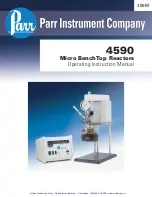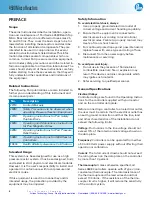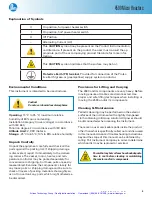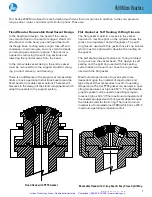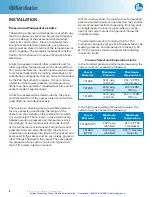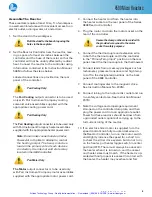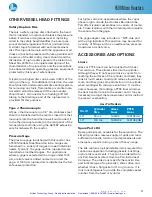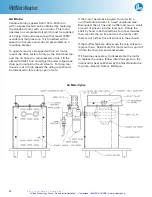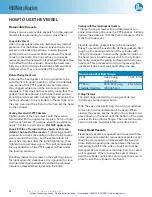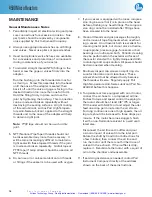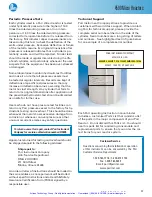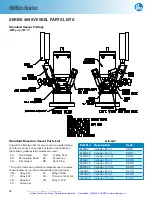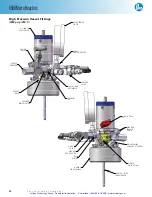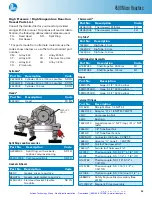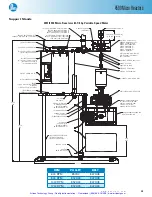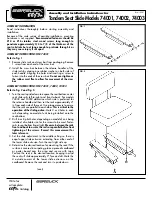
4590 Micro Reactors
P a r r I n s t r u m e n t C o m p a n y
14
HOW TO USE THE VESSEL
Removable Vessels
Always remove removable vessels from the support
stand before attempting to open or close them.
To open the Vessel
Open the gas release valve to discharge any internal
pressure. For the bolted closure, loosen the six cap
screws in the split ring sections. Loosen the cone
pointed screw in the outer band and lower the band
to rest on the table. The ring sections can now be
removed, and the head with all attached fittings is free
to be lifted from the cylinder. Handle the head care-
fully so as not to damage the stirring shaft and other
internals when they are outside of the cylinder.
Before Closing the Vessel
Examine the head gasket or o-ring carefully to be
sure that it is in good condition. After considerable
use, some of the PTFE gasket may extrude into a
thin, ragged edge around the inside and outside
diameters. This does not necessarily mean that the
gasket must be replaced, but the extruded portion
should be removed with a sharp knife. Examine the
mating surfaces on the cylinder and head to be sure
they are clean and free from burrs; then set the head
on the cylinder.
Sealing Vessels with PTFE Gaskets
Tighten each of the cap screws with the wrench
furnished with the apparatus. Apply a firm but hard
pull to each screw. If a torque wrench is available,
apply 15 ft-lbs to each screw.
DO NOT apply more
than 25 ft-lbs of torque to these bolts as this can
deform the head of the reactor.
Tightening should
proceed in a criss-cross pattern rather than progres-
sively around the circle. Let the vessel stand for
about five minutes after the initial tightening; then
tighten the cap screws again. This will compensate
for any tendency of the PTFE gasket to flow under
the loading pressure.
Routinely inspect cap screws on the split ring closure
for lubrication and cleanliness. It is important to clean
and lubricate them periodically so that the required
torque is achieved when tightening the bolts.
Sealing with Flexible Graphite Gaskets
Tighten the cap screws with enclosed wrench in
same criss-cross pattern as the PTFE gasket. Initially
tighten the screws to 15 ft-lbs then increase to 20-25
ft-lbs for proper seal.
Flexible graphite gaskets tend to be somewhat
flakey. To extend the useful life of these gaskets, first
rough up the sealing surface of the cylinder with
120 grit sand paper to ensure the gasket remains in
the head groove and does not stick to the cylinder.
Secondly, coat both sealing surfaces with a silicone
lubricant. This process will aid in compressing the
gasket so it does not break apart after one use.
Recommended Bolt Torque
PTFE
0-3000 psig
(0-200 bar)
15-20 ft-lbs
PTFE or
Flexible Graphite
3000-5000 psig
(200-345 bar)
20-25 ft-lbs
O-Ring Closures
The split rings used with an o-ring seal do not
include any compression bolts.
With the easy close split ring, the o-ring is attached
to the pilot on the underside of the head. When
closing the vessel, set the head on the cylinder and
press down on the head until the bottom of the head
meets with the cylinder flange. Then install the two
split ring halves and attach the outer drop band.
Fixed Head Vessels
Fixed head vessels are opened and closed with the
same procedure used for removable vessels except
that they are opened and closed with the head in
place. Before opening the vessel lower the heater
and swing it well to the side so that it will not be
damaged by any materials that drip from the vessel
as it is opened. When closing the vessel always
hold the cylinder until both split ring sections are in
place to lock the cylinder to the head.
Artisan Technology Group - Quality Instrumentation ... Guaranteed | (888) 88-SOURCE | www.artisantg.com


